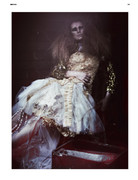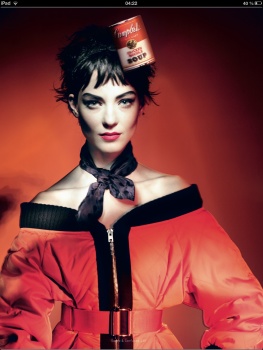You are using an out of date browser. It may not display this or other websites correctly.
You should upgrade or use an alternative browser.
You should upgrade or use an alternative browser.
Robbie Spencer - Stylist
- Thread starter BerlinRocks
- Start date
CrisGalaxy
Active Member
- Joined
- Jun 21, 2009
- Messages
- 2,336
- Reaction score
- 32

topman.comThe Senior Fashion Editor At Dazed & Confused Tells Us All About His Journey Into The Fashion Firmament And Explains Why Anyone Interested In The Art of Style Has To Know Their References
Text John-Paul Pryor
Photography: Damien Fry
Robbie Spencer is renowned in fashion circles as one of those stylists who don't just think outside the box, but turn the box inside out, punch sizeable holes in it, kick it around a little until it's practically unrecognisable and then burn whatever remains. Originally an art student, he cut his teeth doing various internships until he found his home at east London's style bible Dazed & Confused, where he assisted some of the super-stylists of the 90s and turned his formidable intellect to fashion. Now consultant to McQueen's younger line McQ, he is still producing fashion editorial work with cutting-edge artists and photographers such as Richard Burbridge and Ben Toms, as well as busying himself as a menswear stylist on fashion shows all over the globe season-to-season. Here, he tells us why he wants every image he creates to have artistic integrity, why fashion needs shaking up more than ever, and why the work must always come before the personality.
Topman GENERATION: Can you remember the very first images that turned you on to fashion and made you want to express yourself in a visual way?
Robbie Spencer: I guess, initially, I didn’t actually start off with any direct interest in fashion. I had an interest in spatial design and the context of images, as opposed to details of clothing – that’s something that developed quite a lot later on. I did an art foundation back in my hometown, Swindon, and then I moved to London when I was about 19. I started off doing a degree at Chelsea School of Arts, but I discovered it was about lots of technical drawing, and I realised ‘I don’t think I want to be doing that’. (Laughs) It's very hard and you have to be quite mathematically inclined. Also, it’s quite a detailed process (and quite boring), so I changed and went on to do an art degree at Central St Martins, and I got really frustrated by that too, because it didn’t have any vocational focus.
Topman GENERATION: What came next? How did you make the transition to fashion?
Robbie Spencer: Well, in the meantime a lot of my friends started to do internships at magazines, and I was doing internships at the same time – but more design-led ones. I think the first one I did was at World of Interiors, which was all about space and quite stylised interiors, so I got a bit bored with that and ended up doing a bunch of other magazine internships, which was around the same time I started at Dazed & Confused. Immediately, I could see Dazed was a creative outlet and a real creative platform, and that the tool was clothing – you could see that it was a place where you could find creative relief, but also quite clearly a pathway to a career. When I changed to a journalistic degree at the London College of Fashion I had already been at Dazed as an assistant for quite a while. I just stayed at Dazed all the way through my degree.
Topman GENERATION: What drives you? Is it important that for you to impact upon culture visually, or are you more interested in reflecting culture?
Robbie Spencer: I’m really interested in history and if I hadn’t been at Dazed then I probably would have done a history of art degree, or something. I would like to think that all my work has that element of historical reference to it. Even if you don’t necessarily see it in it in there, it's important to me that it has some kind of context, art reference, or historical reference.
Topman GENERATION: Your War Hero shoot for Dazed is kind of a great example of that – it was almost anti-fashion; very challenging…
Robbie Spencer: The War Hero story was based on a documentary I watched about these soldiers from WW2 who were the guinea pigs of plastic surgery – doctors literally patched on parts of skin because they had to recreate the parts of their faces that had been so badly injured. There are these amazing images of men who have these severe disfigurements, but it was a case of either you have that or you wouldn’t have survived – at least it was an attempt to get back to the way they used to look. I showed Richard Burbridge the references – a photographer I really admire in the way that he is also very driven by art references and historical references. He’s been around for quite a long time but I like his approach in that he is very interested in the art world, and for him it’s all about making impactful images – something that I’d really like to think I do also.
Topman GENERATION: It sounds like you consider fashion to be a receptacle for artistic discourse – is that because fashion is in the public sphere and, as such, is a powerful way to channel art?
Robbie Spencer: I think it’s a good tool for that – to suggest ideas and make people think – some of the most amazing designers use it as a way of communicating ideas and I think that that’s a really important thing that we shouldn’t lose, and we shouldn’t compromise on that for the sake of commerciality. You want to inspire the industry as a stylist. Especially now that the industry is so driven by commerciality, you want to feel like you give something back to such an important industry. The idea of performance in fashion and art in fashion used to get dumbed down a lot, and it’s very easy to succumb to the commerciality of it all, but I think you have to keep pushing ideas and keep doing things that surprise people.
Topman GENERATION: Do you think that for some stylists it’s all about that notion of visually channeling or reflecting your own identity?
Robbie Spencer: I don’t think it’s necessarily a way to express my identity but I definitely think that it’s a way to express ideas. I think the satisfaction is getting a response from someone. It’s really amazing when you get a student from some provincial town messaging you saying how much it’s inspired them, or you get a not from someone like Muccia Prada saying they loved an image – you get a lot of satisfaction out of that because you feel like they’re actually seeing it and that you are connected in some way, and that they actually felt something. A few photographers and a few designers do that in their work, where you actually feel something in what they’re doing. It’s difficult with a stylist, because they don’t actually own an image – you just create an image, but you don’t necessarily have ownership over it; you’re just a team player in it.
Topman GENERATION: How do you feel about the culture of the ‘celebrity stylist’?
Robbie Spencer: I don’t think I’m one of those showier stylists, where I put on big show and go out to get myself photographed – although it is increasingly becoming part of the job. I would rather be taken for my integrity and what I’m actually doing than the other way round. It is a part of the industry, being a kind of ‘showman’ in a way, but I’d rather be known for what I’ve done.
John-Paul Pryor is editor of Topman GENERATION, contributing arts editor at AnOther Magazine, editor-at-large for PORT magazine and regularly writes for Dazed & Confused, TANK and Sabotage Times
XavierRaphael
Active Member
- Joined
- Aug 15, 2008
- Messages
- 2,144
- Reaction score
- 56
Great interview! He sounds very interesting. Would love to have a conversation with him.
tentalicious
Active Member
- Joined
- Mar 24, 2010
- Messages
- 6,494
- Reaction score
- 15
MartiniKiss
Active Member
- Joined
- May 27, 2010
- Messages
- 36,766
- Reaction score
- 53
AnOther Magazine Fall / Winter 12.13
Ben Toms (Photographer)
Robbie Spencer (Fashion Editor/Stylist)
Raphael Salley (Hair Stylist)
Shinobu (Makeup Artist)
Janina Pedan (Set Designer)
Angus Munro for AM Casting (Casting Director)
Noah Shelley for AM Casting (Casting Director)
Models: Kolfinna Kristofersdottir, Kremi Otashliyska,Sojourner Morrell, Marte Mei van Haaster














models.com
Ben Toms (Photographer)
Robbie Spencer (Fashion Editor/Stylist)
Raphael Salley (Hair Stylist)
Shinobu (Makeup Artist)
Janina Pedan (Set Designer)
Angus Munro for AM Casting (Casting Director)
Noah Shelley for AM Casting (Casting Director)
Models: Kolfinna Kristofersdottir, Kremi Otashliyska,Sojourner Morrell, Marte Mei van Haaster














models.com
HeatherAnne
Well-Known Member
- Joined
- Jan 24, 2008
- Messages
- 24,230
- Reaction score
- 994
MartiniKiss
Active Member
- Joined
- May 27, 2010
- Messages
- 36,766
- Reaction score
- 53
VogueGirl8910
Well-Known Member
- Joined
- Apr 14, 2008
- Messages
- 47,981
- Reaction score
- 8,809
Melancholybaby
Well-Known Member
- Joined
- Aug 25, 2011
- Messages
- 14,158
- Reaction score
- 2,331
Melancholybaby
Well-Known Member
- Joined
- Aug 25, 2011
- Messages
- 14,158
- Reaction score
- 2,331
VogueGirl8910
Well-Known Member
- Joined
- Apr 14, 2008
- Messages
- 47,981
- Reaction score
- 8,809
VogueGirl8910
Well-Known Member
- Joined
- Apr 14, 2008
- Messages
- 47,981
- Reaction score
- 8,809
VogueGirl8910
Well-Known Member
- Joined
- Apr 14, 2008
- Messages
- 47,981
- Reaction score
- 8,809
VogueGirl8910
Well-Known Member
- Joined
- Apr 14, 2008
- Messages
- 47,981
- Reaction score
- 8,809
Similar Threads
Users who are viewing this thread
Total: 1 (members: 0, guests: 1)




























































































































